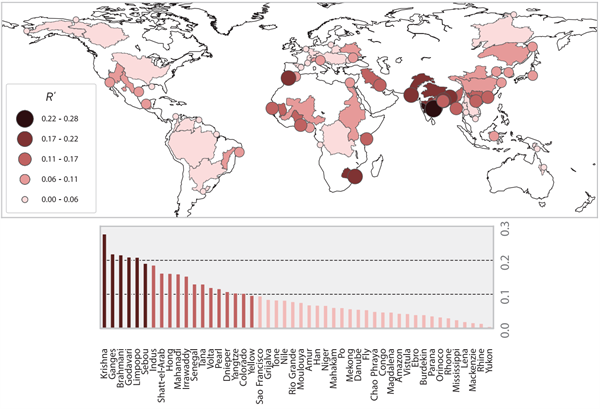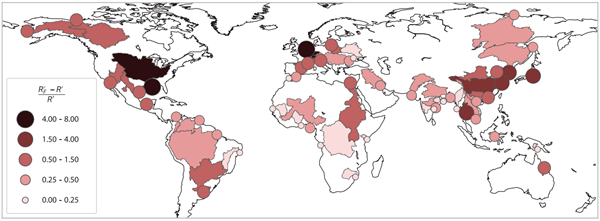Robert McSweeney
06.08.2015 | 7:00pmRising seas, sinking land and increasingly expensive flood defences could see the risk of flooding in deltas such as the Mississippi and Rhine rise eight-fold, a new study finds.
Researchers assessed the current and future flood risk in 48 deltas around the world and found that those in developed countries could face the biggest increase in risks if they can’t maintain their investments in flood defences.
The Delta blues
Deltas form where rivers flow into the sea and deposit the sediment they’re carrying. Some of the largest cities in the world are built on river deltas, from Cairo and Chittagong to Shanghai and San Francisco.
This sediment compacts naturally over time. So to keep the land surface from subsiding, the delta needs a regular top up, says Dr Zachary Tessler, a researcher at the City University of New York. He explains to Carbon Brief:
But human development can get in the way of this natural process, Tessler says:
Building dams and reservoirs upstream of the delta holds back sediment, while using dikes and levees to control water levels can stop sediment from spreading onto the delta, Tessler says.Without adding new sediment, the land surface subsides, leaving deltas more at risk from flooding – both from the river that feeds it and the rising seas it flows into.
For cities built on river deltas, many have flood defences to protect them, but these need regular improvement and investment to keep a city protected.
Developed countries can typically afford to do this, but what if they couldn’t? Tessler’s study, published today in Science, asks that very question.
Risk and exposure
The researchers assessed the risk of flooding at 48 major coastal deltas across the world, home to around 340m people between them.

Map of the 48 deltas included in the study. Source: Tessler et al. (2015).
They considered three factors in calculating risk: the probability of a flood event; the number of people at risk; and the potential harm or loss that a flood would cause.
The map below shows how flood risk is changing in the present day, taking into account observed sea level rise, subsidence of the delta, and any existing flood defences. The darker the circle, the quicker the risk has grown between 1993 and 2013, while the circles indicate the size of the population exposed to flooding.
Many of the deltas at most risk are in developing countries, such as the Ganges-Brahmaputra in Bangladesh and India, the Limpopo in Mozambique, and the Sebou in Morocco.

Rate of changing flood risk (“R”) in the present day for the 48 deltas. Map: The colour and size of the circles represent the level of risk and how many people exposed, respectively. Shaded areas show the river basin that feeds each delta. Chart: deltas ranked by flood risk. Source: Tessler et al. (2015).
Unsustainable
Deltas in developed countries tend to have lower levels of risk at the moment, the paper says, largely because of higher investment in flood defence infrastructure.
But these defences don’t come cheap. Upkeep and improvement of flood defences along the Netherlands coastline are expected to cost â?¬1-2bn per year through this century, for example.
With sea levels rising and deltas subsiding, such costly engineering solutions to flood risk may become unsustainable to maintain, the paper says.
To test what effect this would have on flood risk, Tessler and colleagues ran a scenario where energy prices grow more quickly than each country’s economy.
The map below shows the increase in flood risk over the next 50 years if investment in defences can’t keep pace with rising costs and so stays at current levels.
While flood risk increases for all deltas, the largest increases were found in developed countries, the researchers say. These include the Rhine in the Netherlands, the Mississippi in the US, where risks increase by between four and eight times. This is because they rely heavily on investment in their defences to keep floods at bay.

Flood risk growth over 50 years under reduced infrastructure investment for the 48 deltas. The colour and size of the circles represent the growth in risk and how many people exposed, respectively. Source: Tessler et al. (2015).
Maintaining protection
If costs of defences do rise quickly in the future, there will have to be a trade-off in how much investment is made, says Tessler:
In other words, countries will be left with a choice: maintaining current levels of spending, but seeing risks rise; or maintaining the current level of defences, but seeing costs increase.
The results show that having the financial clout to pay for flood defences will be a key factor in determining how sustainable deltas are, say the researchers. But defences only treat the symptoms of flood risk, not the causes, warns Tessler:
And the study is based on the rate at which sea levels have been rising; if this rate of increase speeds up, flood risk would rise even more quickly.
Tessler, Z. D. et al (2015) Profiling risk and sustainability in coastal deltas of the world, Science, doi:10.1126/science.aab3574
-
Rising seas, sinking land & increasingly expensive flood defences could see flooding risk in deltas like the Mississippi & Rhine rise 8-fold

